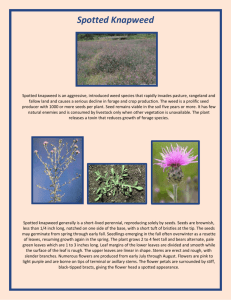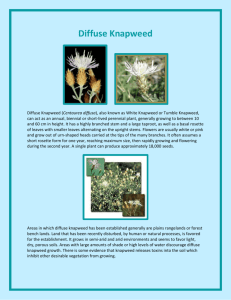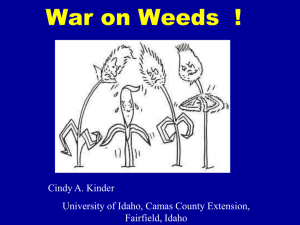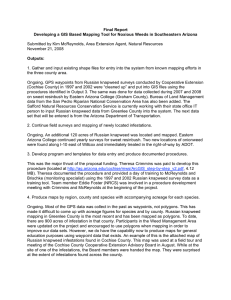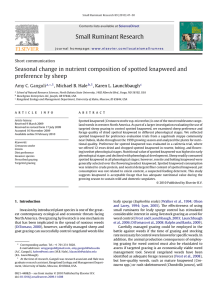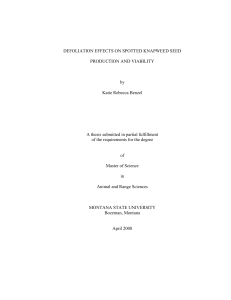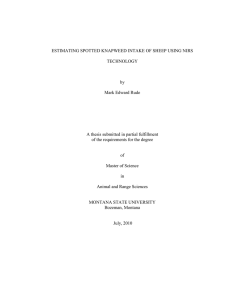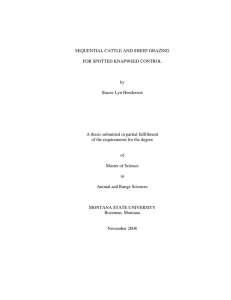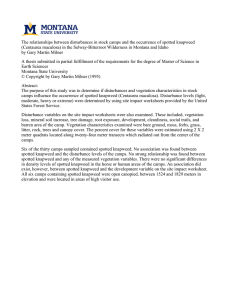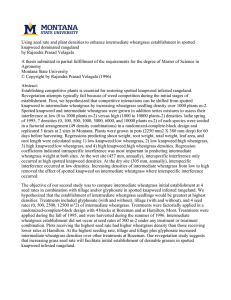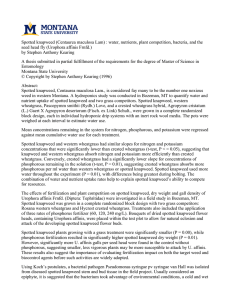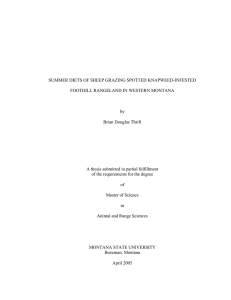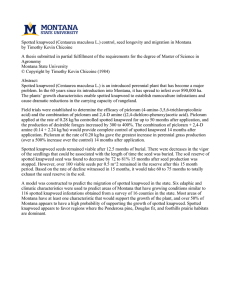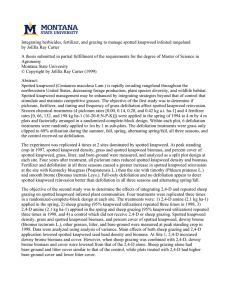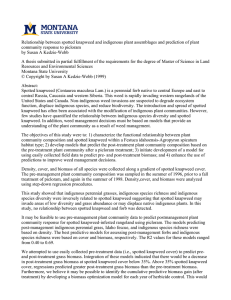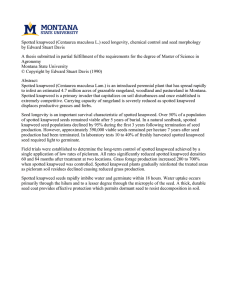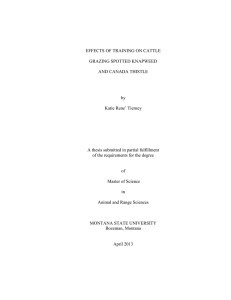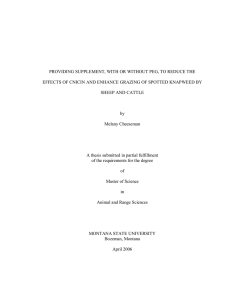Evidence of an Indirect Dispersal Pathway for Spotted Knapweed, Centaurea maculosa,
advertisement
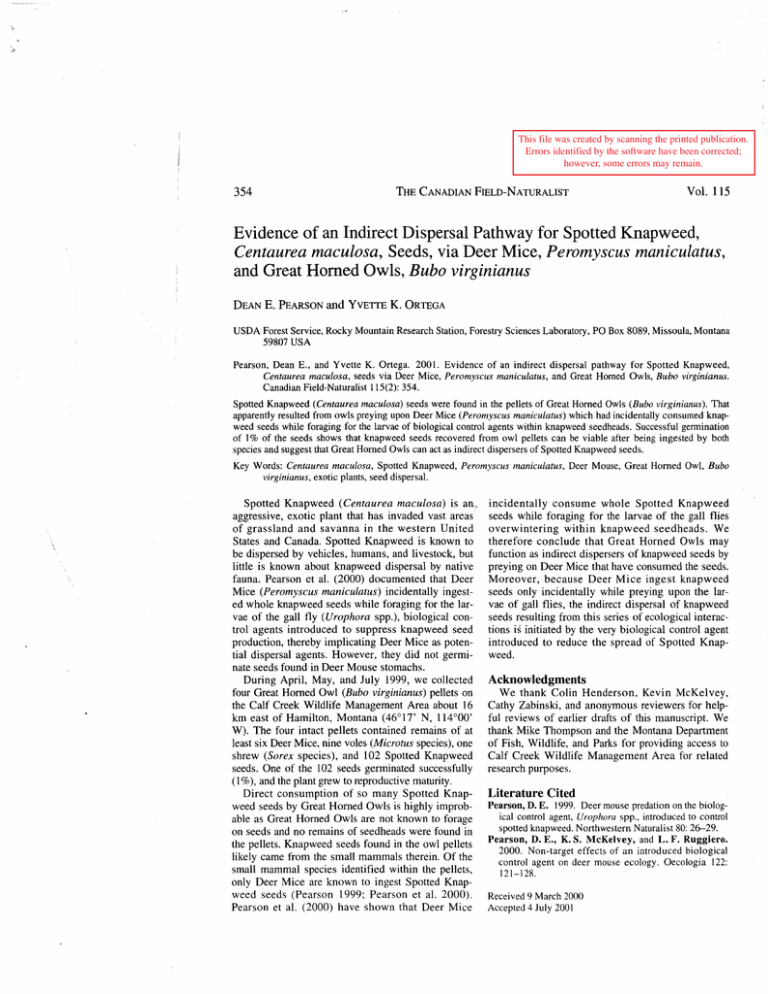
This file was created by scanning the printed publication. Errors identified by the software have been corrected; however, some errors may remain. 354 THE CANADIAN FIELD-NATURALIST Vol. 115 Evidence of an Indirect Dispersal Pathway for Spotted Knapweed, Centaurea maculosa, Seeds, via Deer Mice, Peromyscus maniculatus, and Great Homed Owls, Bubo virginianus DEAN E. PEARSON and YVETTE K. ORTEGA USDA Forest Service, Rocky Mountain Research Station, Forestry Sciences Laboratory, PO Box 8089, Missoula, Montana 59807 USA Pearson, Dean E., and Yvette K. Ortega. 2001. Evidence of an indirect dispersal pathway for Spotted Knapweed, Centaurea maculosa, seeds via Deer Mice, Peromyscus maniculatus, and Great Homed Owls, Bubo virginianus. Canadian Field-Naturalist 115(2): 354. Spotted Knapweed (Centaurea maculosa) seeds were found in the pellets of Great Horned Owls (Bubo virginianus). That apparently resulted from owls preying upon Deer Mice (Peromyscus maniculatus) which had incidentally consumed knapweed seeds while foraging for the larvae of biological control agents within knapweed seedheads. Successful germination of 1% of the seeds shows that knapweed seeds recovered from owl pellets can be viable after being ingested by both species and suggest that Great Horned Owls can act as indirect dispersers of Spotted Knapweed seeds. Key Words: Centaurea maculosa, Spotted Knapweed, Peromyscus maniculatus, Deer Mouse, Great Horned Owl, Bubo virginianus, exotic plants, seed dispersal. Spotted Knapweed (Centaurea maculosa) is an. aggressive, exotic plant that has invaded vast areas of grassland and savanna in the western United States and Canada. Spotted Knapweed is known to be dispersed by vehicles, humans, and livestock, but little is known about knapweed dispersal by native fauna. Pearson et al. (2000) documented that Deer Mice (Peromyscus maniculatus) incidentally ingested whole knapweed seeds while foraging for the larvae of the gall fly (Urophora spp.), biological control agents introduced to suppress knapweed seed production, thereby implicating Deer Mice as potential dispersal agents. However, they did not germinate seeds found in Deer Mouse stomachs. During April, May, and July 1999, we collected four Great Homed Owl (Bubo virginianusi pellets on the Calf Creek Wildlife Management Area about 16 km east of Hamilton, Montana (46°17' N, 114°00' W). The four intact pellets contained remains of at least six Deer Mice, nine voles (Microtus species), one shrew (Sorex species), and 102 Spotted Knapweed seeds. One of the 102 seeds germinated successfully (1 %), and the plant grew to reproductive maturity. Direct consumption of so many Spotted Knapweed seeds by Great Homed Owls is highly improbable as Great Homed Owls are not known to forage on seeds and no remains of seedheads were found in the pellets. Knapweed seeds found in the owl pellets likely came from the small mammals therein. Of the small mammal species identified within the pellets, only Deer Mice are known to ingest Spotted Knapweed seeds (Pearson 1999; Pearson et al. 2000). Pearson et al. (2000) have shown that Deer Mice incidentally consume whole Spotted Knapweed seeds while foraging for the larvae of the gall flies overwintering within knapweed seedheads. We therefore conclude that Great Horned Owls may function as indirect dispersers of knapweed seeds by preying on Deer Mice that have consumed the seeds. Moreover, because Deer Mice ingest knapweed seeds only incidentally while preying upon the larvae of gall flies, the indirect dispersal of knapweed seeds resulting from this series of ecological interactions is initiated by the very biological control agent introduced to reduce the spread of Spotted Knapweed. Acknowledgments We thank Colin Henderson, Kevin McKelvey, Cathy Zabinski, and anonymous reviewers for helpful reviews of earlier drafts of this manuscript. We thank Mike Thompson and the Montana Department of Fish, Wildlife, and Parks for providing access to Calf Creek Wildlife Management Area for related research purposes. Literature Cited Pearson, D. E. 1999. Deer mouse predation on the biological control agent, Urophora spp., introduced to control spotted knapweed. Northwestern Naturalist 80: 26-29. Pearson, D. E., K. S. McKelvey, and L. F. Ruggiero. 2000. Non-target effects of an introduced biological control agent on deer mouse ecology. Oecologia 122: 121-128. Received 9 March 2000 Accepted 4 July 2001
